

Nicolas Flamel. Flamel as represented in 1402 on the portal of Sainte-Geneviève des Ardens (From Étienne François Villain, 1761) Nicolas Flamel (French: [nikɔla flamɛl]; prob.
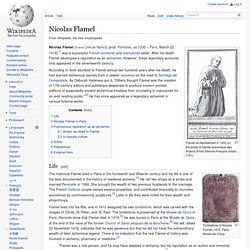
Pontoise, ca 1330 – Paris, March 22, 1418)[1] was a successful French scrivener and manuscript-seller. After his death Flamel developed a reputation as an alchemist. However, these legendary accounts only appeared in the seventeenth century. According to texts ascribed to Flamel almost two hundred years after his death, he had learned alchemical secrets from a Jewish converso on the road to Santiago de Compostela. Life[edit] Tombstone of Nicolas Flamel, 1418, Paris, Musée de Cluny. Alchemy. The Emerald Tablet, a key text of Western Alchemy, in a 17th-century edition Alchemy is an influential philosophical tradition whose practitioners have, from antiquity, claimed it to be the precursor to profound powers.
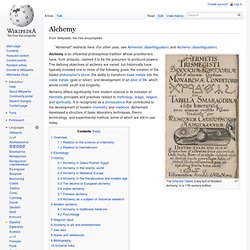
The defining objectives of alchemy are varied, but historically have typically included one or more of the following goals: the creation of the fabled philosopher's stone; the ability to transform base metals into the noble metals (gold or silver); and development of an elixir of life, which would confer youth and longevity. Overview[edit] Alchemy is the art of liberating parts of the Cosmos from temporal existence and achieving perfection which, for metals is gold, and for man, longevity, then immortality and, finally, redemption. Modern discussions of alchemy are generally split into an examination of its exoteric practical applications and its esoteric aspects. The Book of Abramelin. Mathers used the least-reliable manuscript copy as the basis for his translation, and it contains many errors and omissions.
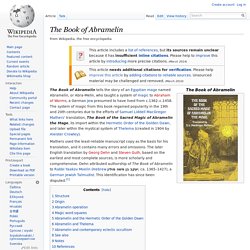
The later English translation by Georg Dehn and Steven Guth, based on the earliest and most complete sources, is more scholarly and comprehensive. Dehn attributed authorship of The Book of Abramelin to Rabbi Yaakov Moelin (Hebrew יעקב בן משה מולין; ca. 1365–1427), a German Jewish Talmudist. This identification has since been disputed.[1] Structure[edit] Origin[edit] The book exists in the form of seven manuscripts and an early printed edition. The first printed version, also in German, dates to 1725 and was printed in Cologne by Peter Hammer.[6] A partial copy in Hebrew is found in the Bodleian Library in Oxford, and dates from around 1740.[7] A manuscript copy existed in French in the Bibliothèque de l'Arsenal in Paris, an institution founded in 1797. Abramelin operation[edit] Magic word squares[edit] Magnum opus (alchemy) Colors of the magnum opus seen on the breastplate of a figure from Splendor Solis The Great Work (Latin: Magnum opus) is an alchemical term for the process of creating the philosopher's stone.
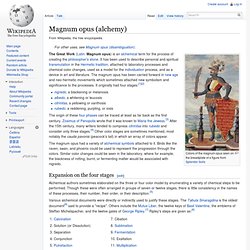
It has been used to describe personal and spiritual transmutation in the Hermetic tradition, attached to laboratory processes and chemical color changes, used as a model for the individuation process, and as a device in art and literature. The magnum opus has been carried forward in new age and neo-hermetic movements which sometimes attached new symbolism and significance to the processes. It originally had four stages:[1][2] Pentacle. The words pentacle and pentagram (a five-point unicursal star) are essentially synonymous, according to the Online Oxford English Dictionary (2007 revision), which traces the etymology through both French and Italian back to Latin, but notes that in Middle French the word "pentacle" was used to refer to any talisman.
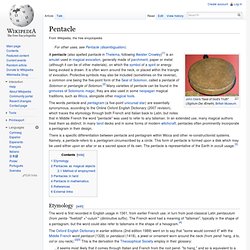
In an extended use, many magical authors treat them as distinct. In many tarot decks and in some forms of modern witchcraft, pentacles often prominently incorporate a pentagram in their design. There is a specific differentiation between pentacle and pentagram within Wicca and other re-constructionist systems. Namely, a pentacle refers to a pentagram circumscribed by a circle. This form of pentacle is formed upon a disk which may be used either upon an altar or as a sacred space of its own. Etymology[edit] ...it seems most likely that it comes through Italian and French from the root pend- "to hang," and so is equivalent to a pendant or charm hung about the neck. ...
Cintamani. Cintāmaṇi (Sanskrit; Devanagari: चिन्तामणि) also spelled as Chintamani (or the Chintamani Stone) is a wish-fulfilling jewel within both Hindu and Buddhist traditions, equivalent to the philosopher's stone (Paras Pathar) in Western alchemy.[1] In Buddhism it is held by the bodhisattvas, Avalokiteshvara and Ksitigarbha.
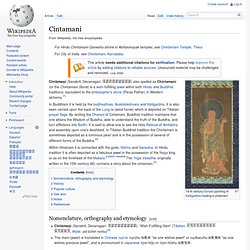
It is also seen carried upon the back of the Lung ta (wind horse) which is depicted on Tibetan prayer flags. By reciting the Dharani of Cintamani, Buddhist tradition maintains that one attains the Wisdom of Buddha, able to understand the truth of the Buddha, and turn afflictions into Bodhi. It is said to allow one to see the Holy Retinue of Amitabha and assembly upon one's deathbed. Philosopher's stone. History[edit] Mention of the philosophers' stone in writing can be found as far back as Cheirokmeta by Zosimos of Panopolis (c. 300 AD).[2] Alchemical writers assign a longer history.
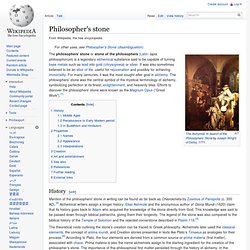
Elias Ashmole and the anonymous author of Gloria Mundi (1620) claim that its history goes back to Adam who acquired the knowledge of the stone directly from God. This knowledge was said to be passed down through biblical patriarchs, giving them their longevity.